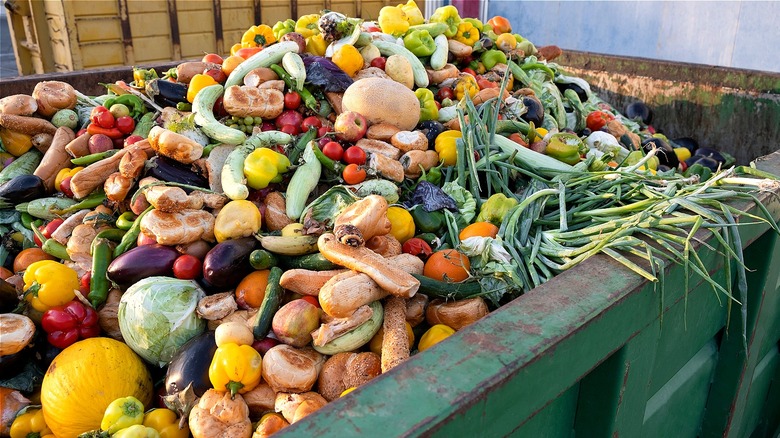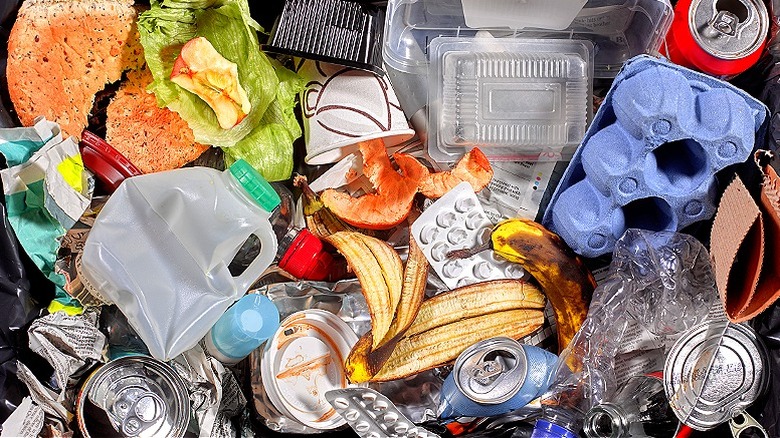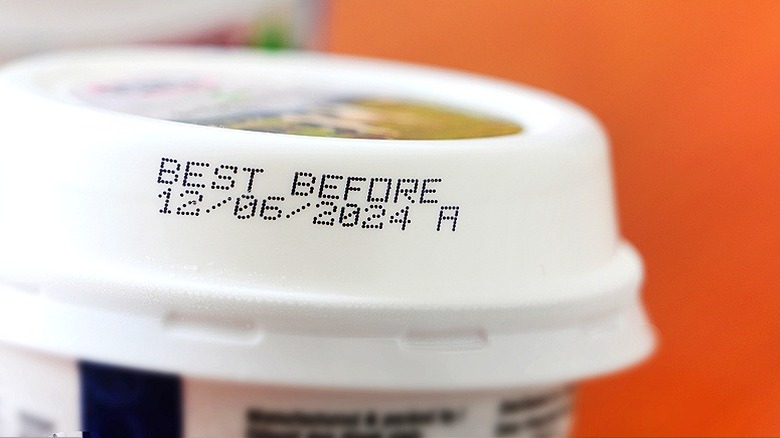The Amount Of Money Americans Lose To Uneaten Food Each Year Is Staggering
Increasing prices have been a near constant concern for many in the United States since the end of the pandemic. No spending category has been safe from inflation and, in many cases, greedflation and shrinkflation have further contributed to the current consumer economy. This is why you're not alone in feeling like food, in particular, has gotten significantly more expensive. In fact, according to Consumer Price Index data, food costs have increased 25% since 2019. This can (and has) left more and more families concerned about their ability to continue to provide for themselves. However, with that in mind, there are some consumer behaviors that can further exacerbate this financial problem.
Perhaps one of the most significant considerations for families to factor into their grocery expenses is just how much food they might waste in a week or month. While grocery prices continue to climb, food waste can have even more significant financial consequences for a family's budget. According to the U.S. Department of Agriculture, Americans lose a lot of money on uneaten and wasted food, with the average family of four losing about $1,500 every year to uneaten food.
While the economics of this food waste is already bad, environmental considerations make the situation even more serious. Let's dive into the current data on just how much food the U.S. wastes every year, as well as some of the main reasons why this food waste happens in the first place.
Food waste data
A 2023 food waste study from MITRE and Gallup found that one-third of the country's entire food supply ends up being wasted. In more precise terms, the average household wastes about 6.2 cups of food in a week, with fresh produce such as fruits and vegetables being at the top of the list for most wasted food types. According to the study, the overall amount of food wasted in the U.S. could fill over 1 million dump trucks a year.
The environmental impact of this wasted food can have even more far-reaching consequences. For example, the water required to produce only the food that ends up being wasted in the United States is equivalent to 9 million Olympic-sized swimming pools. Plus, this food comes from an agricultural area that would be equal to the entire size of the states of California and New York combined. What's more, the impact of this food waste further contributes to climate change, which can have financially significant consequences for consumers, as the prices of things like homeowners and car insurance continue to rise due to climate change-fueled disasters.
To get back to just the financial implications of food waste on families, it's important to realize a typical family could save between $100 and $300 each month if they prioritize combating food waste in their home. It's also worth mentioning that certain states report higher levels of food waste than others. For instance, Arkansas, Maryland, and Illinois have the highest levels of food waste while Wyoming, Maine, and Idaho have the least.
Food date labels
A large initiative to combat food waste actually centers on food date labels, or the "best by" dates printed on food items. According to research from Recycle Track Systems, over 80% of consumers end up throwing away consumable food due to misunderstanding the expiration or food date labels included on their food. Part of the problem stems from the fact that food-date labeling isn't federally regulated, which leads to inconsistencies and confusion that contribute to unnecessary food waste.
For those who might not know, most expiration dates listed on food items are not actually tied to food safety. Oftentimes, these dates instead indicate when the quality of the food item might peak. Meaning, certain unopened pantry staples might be slightly stale but are certainly not unsafe to eat past their printed food-date labels. However, the current confusion surrounding food labels instead means that 31% of American consumers often throw away perfectly good food based on the date they find on these labels.
Congress has even introduced something known as the Food Date Labeling Act of 2023. If passed, the act would essentially standardize food-date labeling into two possible categories: "BEST if used by" to help consumers understand food quality changes and "USE by" for a more specific time frame on actual validity. The bill also includes specific education requirements for the public in order to make the meanings behind those two date labels clear to consumers.


